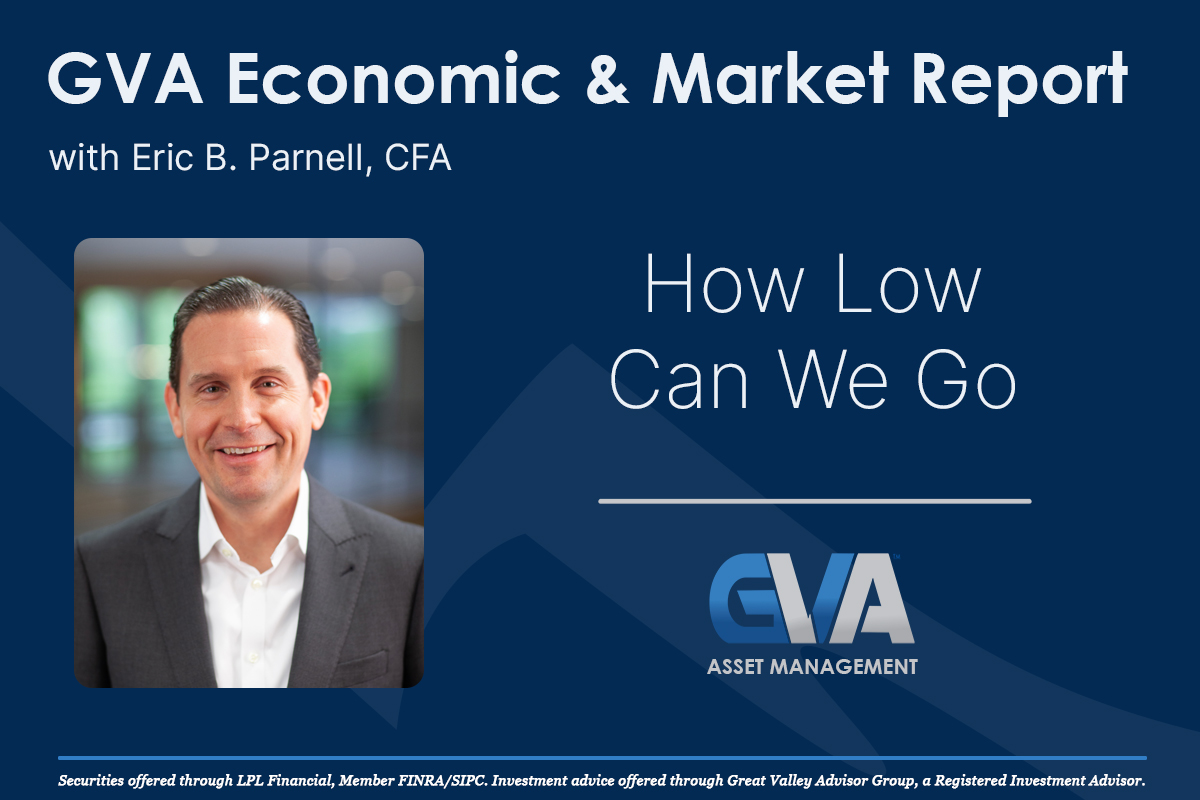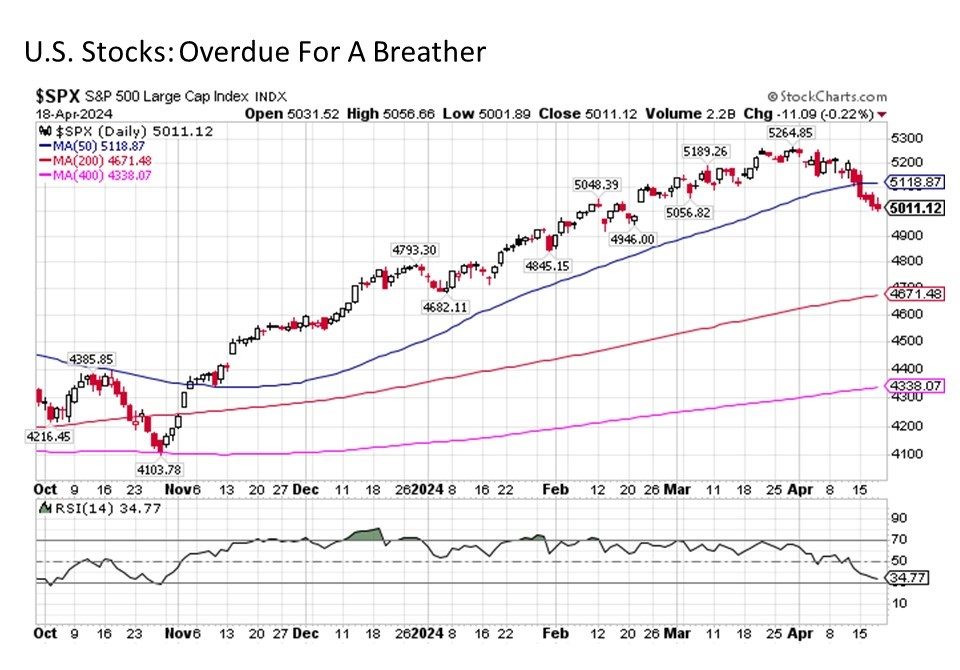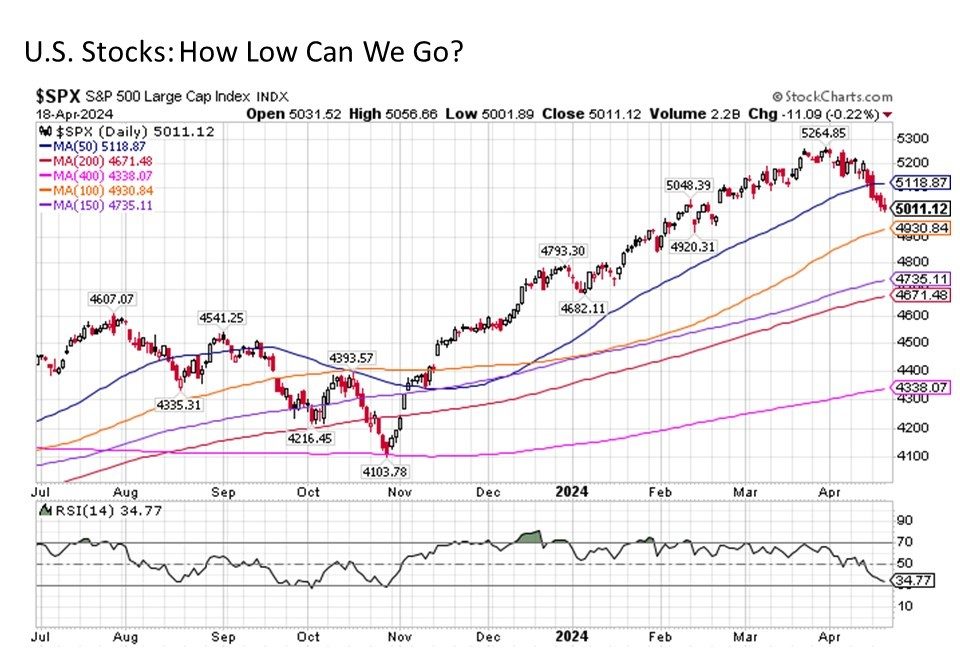
The long overdue correction has finally arrived. No sooner did the market peak at 5264 on the last trading day of March than the calendar flipped to the start of the second quarter and the market has been moving sustainably to the downside. Now that the correction is underway, how low can we reasonably expect the market to go?
Why overdue? So why is the current correction considered overdue. Put simply, because the market has been running well above trend for many months now. Following the difficult stretch from August to October last year, the U.S. stock market exploded to the upside. By the end of last year, the S&P 500 was trading well above its 50-day moving average (blue line below), which was well above its 200-day moving average (red line below) that was well above its 400-day moving average (pink line below). And these gaps only widened further following the explosive start to 2024 for U.S. stocks.

The more the market is trading above these trendlines and the wider the gap between these moving average trendlines, the more the market is deviating too far from trend in one direction and becomes overdue to revert back to its trendline means. The fact that the S&P 500 went through extended periods with a Relative Strength Index (RSI) reading above 70 (overbought, and thus due for a correction) was added confirmation that the market from November to March had become frothy.
How low so far? It has been a difficult April for the U.S. stock market so far with the overdue correction finally getting underway. The S&P 500 Index has closed lower in ten out of the first fourteen trading days this month. Notably, a number of these down days were marked by stocks trading strongly higher early in the session only to give up these gains and more by the close. In the process, the benchmark index has fallen -5% peak-to-trough from its end of March peak.
Any cause for prolonged concern? It’s never pleasant to see the value of our investment portfolios decline in value, but it is an inevitable part of long-term investing in risk assets that fluctuate in price at any given point in time. And the good news is that the underlying fundamentals supporting today’s market remain strong. Economic growth for 2024 so far has been much stronger than anticipated coming into the year, with projections for 2024 Q1 Real GDP growth coming in as high as +3%. Corporate earnings growth is also set to increase by double digits through the remainder of 2024, which is also constructive. And while valuations on the S&P 500 remain elevated versus historical averages, the premium multiples are concentrated in the well known high flyers of recent years. Looking beyond these mega names, the rest of the market is trading at discounted multiples last seen several years ago.
As a result, the current correction can be reasonably viewed as a healthy and orderly market consolidation after a recently strong run to the upside. Such pullbacks are good for the market long-term, as they help clear out excesses and misallocation of capital while providing more attractive entry points for new capital to be put to work in the markets.
How low can we go? If this is indeed a garden variety short-term pullback within a longer term uptrend, it is reasonable to consider how much lower we should anticipate the market will go.
First, it is worthwhile to note that when the stock market enters into a corrective period within a longer term bull market, the depth of the decline averages between -5% and -12% and typically lasts anywhere between four and twelve weeks. To date, although we are already down -5%, we are only in our third week of the correction. As a result, we should reasonably expect that the current decline may continue for at least a few more weeks and may stretch toward the higher end of the historical average range, particularly given that the market was so overextended heading into the correction. Put differently, even if we see a stock market still moving lower into double-digits by May or June, this is still in the context of a short-term pullback within a long-term uptrend. It is worth remembering that the S&P 500 declined by -11% peak to trough over a thirteen week period from August to October last year, only to subsequently rally by nearly +30% in the five months since.

Next, it is worth noting that the S&P 500 has already broken below its medium-term 50-day moving average support. This took place decisively on Monday, and thus signals that the market is likely starting into its next leg lower. The next landing spot of support for the S&P 500 is its 100-day moving average (orange line above), currently at 4930 and rising. This would mark a roughly -6% peak-to-trough decline in the headline index. While we may see a modest bounce from this support level, particularly now that stocks are approaching oversold levels (30 or less) on its RSI, the correction likely has further to go from there.
Lastly, the next key level to watch would be 4800 on the S&P 500. This is not only where the rising 150-day (purple line above) and 200-day moving averages are converging in the coming weeks, but it also happens to be near the level where the S&P 500 started the year. Not only would this give us a -9% peak-to-trough decline, but for all of those investors that were waiting for a pullback at the start of the year only to see U.S. stocks surge by roughly +10% in the first three months of the year, this will be their second chance to get back into the market. Such is the buying pressure that can help arrest a decline to the downside and provide the foundation for a fresh new sustained move to the upside.
Bottom line. The U.S. stock market has recently fallen into correction, and we should not be surprised if this pullback extends further into the second quarter and takes a few more percentage points off of the S&P 500 Index. But behind so many short-term pullbacks are long-term buying opportunities, and investors may be well served to view this recent market decline with a measure of longer term optimism.
Disclosure: I/we have no stock, option or similar derivative position in any of the companies mentioned, and no plans to initiate any such positions within the next 72 hours. I wrote this article myself, and it expresses my own opinions. I am not receiving compensation for it. I have no business relationship with any company whose stock is mentioned in this article. Investment advice offered through Great Valley Advisor Group (GVA), a Registered Investment Advisor. I am solely an investment advisor representative of Great Valley Advisor Group, and not affiliated with LPL Financial. Any opinions or views expressed by me are not those of LPL Financial. This is not intended to be used as tax or legal advice. All performance referenced is historical and is no guarantee of future results. All indices are unmanaged and may not be invested into directly. Please consult a tax or legal professional for specific information and advice.
Compliance Tracking #: 568588-1
